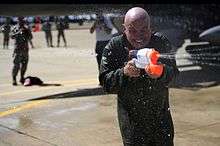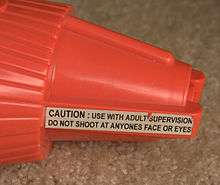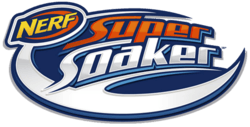Super Soaker
|
Logo launched in 2014. | |
| Type | Water gun |
|---|---|
| Inventor | Lonnie Johnson |
| Company | |
| Country | United States |
| Availability | 1990–Present |
| Materials | Plastic + metal and latex parts |
| Slogan |
"Wetter Is Better!" (classic) "It's Nerf or Nothin'!" (present) |
| Official website | |
Super Soaker is a brand of recreational water gun that utilizes manually-pressurized air to shoot water with greater power, range, and accuracy than conventional squirt pistols. The Super Soaker was invented in 1982 by engineer Lonnie Johnson. The prototype combined PVC pipe, acrylic glass, and an empty plastic soda bottle.[1]
Originally sold by Larami and now produced by Hasbro under the Nerf brand, Super Soaker has generated more than $1 billion in total sales.[1] The first Super Soaker went on sale in 1990 and was originally called the Power Drencher, or the "Shaw" because of its ability to shoot straight and narrow. [2][3] Rebranding the name to Super Soaker occurred in 1991 together with a series of TV advertisements that resulted in 2 million water guns being sold.[1] Super Soakers were popular for many years — so popular, in fact, that the term super soaker is sometimes used generically, to refer to any type of toy pressurized water gun.
History
In 1982, Air Force and NASA engineer Lonnie Johnson conceived of the idea of a pressurized water gun after shooting a powerful stream of water in his bathroom while performing experiments for a new type of refrigeration system. Several months later he built a prototype in his basement. Johnson originally wanted to produce the toy himself, but realized that the costs were out of his reach. He attempted to arrange partnerships with toy companies to bring the product to market, but it was not until 1989 that he found success. While at the American International Toy Fair in New York City, he met the vice president of the toy company Larami, who showed interest in the idea. In 1982, Lonnie Johnson decided to shift his focus from his current scientific career at NASA to the Super Soaker because the Super Soaker could potentially create enough funding for his own research goals. The revenue that Lonnie received from the Super Soaker licensing provided enough money for Lonnie to create Johnson Research & Development Co., Inc.[4] Johnson then went home and built an improved prototype and made a trip to their headquarters in Philadelphia where he made a successful sales pitch.[5] Refinements made with Larami employee Bruce D'Andrade made its mass production feasible,[2] and the first commercial version of the water gun appeared in stores the following year as the Power Drencher. In 1991 it achieved commercial success under its new name, Super Soaker.[5]
Technology
Piston pumper
Piston water guns have been produced for many years.[6] These guns do not have triggers; they are fired simply by pumping. Although this design feature allows them to reload rapidly, piston pumpers tend to have less range and less power than other designs.
Air pressure (pressurized reservoir)
Originally made popular by the Super Soaker 50,[7][8] pressurized reservoir systems are still common for small water guns. A water gun using this system is pressurized by air being pumped and compressed into its reservoir. When the trigger is pulled, a valve is opened and the compressed air pushes the water out of the nozzle.[9]
Super Soaker started with two pressurized reservoir water guns, and has continued to produce them in various shapes and sizes.
Air pressure (separate chamber)
This is a more powerful air pressure system that was also first introduced by Super Soaker. It is designed so that water is pumped from the reservoir into an empty plastic container. As the water is pumped in, the air sitting inside becomes compressed. When the trigger is pulled, the valve opens and the compressed air forces the water out.[9] The brand first used separate air pressure in 1991 on the Super Soaker 100 and has since used the technology in many other water guns.
Spring-powered
Super Soaker has made a few spring-powered water guns. They first made the Quick Blast in 2008. The Quick Blast was a triggerless gun which functioned similarly to piston pumpers, but had a spring-loaded piston inside. The Quick Blast had a firing valve, which automatically opened once a certain pressure was reached. The spring would then push the water out the nozzle.[10]
The Super Soaker Shot Blast, released in 2010, used a system near identical to the Quick Blast. However, it had different styling.[11]
In 2013, Super Soaker produced the Flash Blast. While this blaster was spring-powered, this pistol-sized blaster used a system different from the previous two. Its slide was cocked back once. Then the trigger was pulled, firing a short stream of water. Function of this gun is similar to Nerf guns.[12]
Motorized
Super Soaker recently made many motorized water guns. In 2011, they released the Thunderstorm, which used an electric pump to push water directly out the nozzle.[13][14] In 2012, Super Soaker made two motorized water guns: The Lightningstorm, a reproduction of the Thunderstorm with added accessories, and the Electrostorm, a smaller motorized gun.[15][16] Each of them required four AA batteries to run.
CPS (Constant Pressure System)
The Constant Pressure System is the most powerful system used by Super Soaker.[17] The user pumps water from the reservoir into a rubber bladder, which expands as more water is forced into it. The stretched rubber exerts a constant pressure on the water, giving the blaster a thick and constant stream throughout the entire shot. In most older models, the resulting blast is forceful enough that recoil can be felt.
Hasbro has implemented the Constant Pressure System in Super Soaker blasters a number of times since completing the takeover of Larami Corp in 2002.[18] The most recent implementation was in the 2011 'Hydro Cannon',[14] while the largest post-takeover pressure chamber (at 900ml) is found in the 2007 'HydroBlitz' blaster.[19][20]
Original series models of Super Soakers

The following are the original models of Super Soaker guns:[21]
- Super Soaker 10
- Weighing in at less than 3 ounces, the SS10 was a sub-compact, pistol-type model that was the easily concealable due to its small size (56 mL tank volume, model year 1993)
- Super Soaker 20
- The SS20 was a pistol-type model which came with an either a rear-mounted or a grip-mounted pump. (115 mL tank volume, model year 1992)
- Super Soaker 25
- Designed with the grip-mounted pump, the SS25 came with a belt and additional, surplus water tank. (177 mL tank volume, model year 1992)
- Super Soaker 30
- The original pistol-sized gun, the SS30 was released with the very first models in 1991. While only slightly heavier than the SS20, it holds more than twice the water in its reservoir. (265 mL tank volume, model year 1991)
- Super Soaker 40
- With a design similar to that of the classic SS50, the SS40 possessed somewhat more compact size dimensions. While it also came with a significantly smaller water reservoir, the SS40 was a later model of more durable construction and was touted on its accompanying packaging as "the most powerful watergun ever!" (490 mL tank volume, model year 1993)
- Super Soaker 50
- The original mid-size weapon, the SS50 was a best-selling model. Known for its impressive range due its novel air pressure system, the SS50 has become a cultural icon. In 2015, the SS50 was the model exemplified when the Super Soaker brand was nominated for the National Toy Hall of Fame. (730 mL tank volume, model year 1991)
- Super Soaker 60
- While still a mid-size weapon, the SS60 was one of the last of the original models and came designed more comparably to the SS100. With an enhanced nozzle, rugged construction, and a separate pressure chamber, the SS60 required less pumps to achieve maximum pressure. (890 mL tank volume, model year 1994)
- Super Soaker 100
- Befitting its triple-digit number designation, this larger-sized weapon was the biggest Super Soaker until the release of the SS200. It came with a weight and tank reservoir double that of most mid-sized models, and was accordingly known for its range and capacity. (1500 mL tank volume, model year 1991)
- Super Soaker 200
- The biggest and heaviest of all the original weapons until the release of the SS300, the Super Soaker 200 came with a carry-strap to increase its ergonomics. This model also came with dual full-size water tanks, a large pressure chamber, and multiple, adjustable nozzle settings. (2050 mL tank volume, model year 1992)
- Super Soaker 300
- Armed with 3 air-pressured firing chambers and sporting the same 6.5 L displacement as a V8 engine, the backpack-fed Super Soaker 300 came with an appropriately wider nozzle-opening for increased output. While the model had some weight and durability issues, it possessed the ability to outclass all other models, particularly in terms of sheer water volume (6500 mL tank volume, model year 1993)
Super Soaker CPS 2000
The Super Soaker CPS 2000 is a CPS class water gun released in 1996 by Larami. It was the first model in the Constant Pressure System (CPS) line, which initially included only a single blaster. Today, it is a sought-after and revered soaker by enthusiasts and members of the online community. It remains the most powerful stock water blaster sold in stores in terms of range and soakage, a title it took from the Super Soaker 300 and has held for 17 years running. The CPS 2000 has gained a reputation for its size and power, since no other water gun comes close to it in terms of power. The CPS 2000 has been criticized for its low field life (how long it can last between refills) depleting its pressure chamber in only 1 second and only being able to fire 4 or 5 such shots before needing to be refilled, and the large number of pumps that it takes to fully pressurize (20-24 depending on version).[22][23]
The original version of the CPS 2000 was released in spring of 1996. Being the first water gun to ever sport a Constant Pressure System (CPS), it began what many refer to as the "third age of water wars" (the first beginning upon the release of the Super Soaker 50 in 1991 and the second after the Super Soaker 300 was released in 1993). The most powerful blaster of its time and still currently unmatched except by homemade water guns, it sports a 25X water output (1X equals 1.2 oz/second).

The CPS 2000 Mk2 was a replacement to the Mk1. This version of the CPS 2000 was lighter, the Mk1 having a pressure chamber with 50% more capacity (30 oz) than the Mk2 (20 oz). sources have reported the Mk1 as having greater shot time, output, and range than the mk2 but the difference is only marginal.
The most visible differences between the two are;
- The Mk1 has a much longer pressure gauge than the Mk2.
- The Mk2 has a tethered reservoir cap to prevent loss, the Mk1's is untethered.
- The pump handle on some Mk2s has a grey disc with a pin visible. This is absent on the Mk1.
Awards
In 2011, the Nerf Super Soaker Shot Blast was awarded "Outdoor Toy of the Year" at the 11th Annual Toy of the Year Awards, which is held at the American International Toy Fair in New York City.[24][25]
In 2015, Super Soaker was inducted to National Toy Hall of Fame.[26]
Legal issues
In 2010, Buzz Bee Toys was successfully sued by Hasbro for patent infringement.[27][28] Hasbro claimed that Buzz Bee Toys infringed on a patent related to its "Super Soaker water toy." Although it is unknown exactly what the dispute was over, it is strongly suggested that Hasbro was suing for the Water Warriors Hydro-Power water guns, which were becoming too similar to Super Soaker's Constant Pressure System. Since then, the Water Warriors line has not contained a single Hydro-Power water gun.[29]
In November 2013, Lonnie Johnson and his company Johnson Research and Development Co. were awarded nearly US$73 million following a dispute with Hasbro over underpaid royalties from 2007 to 2012.[30]
See also
- Water Warriors - A competing brand by Buzz Bee Toys.
- Entertech - A defunct line of water guns from the 1980s by LJN Toys.
- Xploderz - A toy gun line by The Maya Group that uses water-based pellets.
[31]==References==
- 1 2 3 Ryssdal, Kai. "The happy accident that changed squirt guns forever". American Public Media. Retrieved 22 July 2014.
- 1 2 iSoaker.com: History of the Super Soaker
- ↑ "Who invented the Supersoaker?". Customer Service. Hasbro.
- ↑ Smith, Monica. "Meet Lonnie Johnson, the Man Behind the Super Soaker". Lemelson Center. Smithsonian National Museum of American History. Retrieved 3 July 2017.
- 1 2 "Lonnie Johnson: The father of the Super Soaker - BBC News". Retrieved 2016-08-16.
- ↑ "Super Soaker Other Pressurization Systems Soaker Evolution Tree". The Armoury. isoaker.com. Retrieved 20 March 2012.
- ↑ "Super Soaker 50". The Armoury. isoaker.com. Retrieved 20 March 2012.
- ↑ Murrie, Steve and Matthew (2007). Every Minute On Earth. Page 172: September 1, 2007. p. 172. ISBN 0439908876.
- 1 2 "How water guns work". Physics. Super Soaker Central. Retrieved 20 March 2012.
- ↑ "Super Soaker Quick Blast". iSoaker. iSoaker.com. Retrieved 13 May 2013.
- ↑ "Super Soaker Shot Blast". iSoaker. iSoaker.com. Retrieved 13 May 2013.
- ↑ "Super Soaker Flash Blast". iSoaker. iSoaker.com. Retrieved 13 May 2013.
- ↑ "Super Soaker Thunderstorm". iSoaker. iSoaker.com. Retrieved 13 May 2013.
- 1 2 "NERF Super Soakers". TheHotToys. TheHotToys.com. Retrieved 26 August 2013.
- ↑ "Super Soaker Lightningstorm". iSoaker. iSoaker.com. Retrieved 13 May 2013.
- ↑ "Super Soaker Electrostorm". iSoaker. iSoaker.com. Retrieved 13 May 2013.
- ↑ iSoaker.com: Armoury -Super Soaker CPS 2000, Manufactured by Larami Ltd., 1996
- ↑ When and How Did Super Soaker Get "Nerfed"? | iSoaker.com
- ↑ "Super Soaker Hydro Cannon". iSoaker. iSoaker.com. Retrieved 13 May 2013.
- ↑ Super Soaker HydroBlitz (Aquashock Series) | iSoaker.com
- ↑ "Super Soaker Original Classic Series". www.isoaker.com. Retrieved November 4, 2015.
- ↑ "Stop, and read this article". SSCentral. 2004-08-10. Archived from the original on 2005-02-11. Retrieved 2011-08-01.
- ↑ "Super Soaker CPS 2000". Retrieved 2011-08-01.
- ↑ Per-Lee, Myra. "The 11 Best Toys of 2011". InventorSpot. Retrieved 2011-02-15.
- ↑ "Toy of the Year 2011 Award Winners". TheHotToys. TheHotToys.com. Retrieved 26 August 2013.
- ↑ "Three toys are new inductees to National Toy Hall of Fame - Rochester Business Journal New York business news and information".
- ↑ "Hasbro sues other toy makers over patents". 2 June 2010. Retrieved 20 March 2012.
- ↑ Skariachan, Dhanya (2010-11-30). "UPDATE 1-Hasbro wins patent case against Buzz Bee". Reuters. Retrieved 2013-05-20.
- ↑ "Water Gun / Water Blaster Product Analyses Listings / Soaker Database (water warriors blasters)". The Armoury. isoaker.com. Retrieved 20 March 2012.
- ↑ Seward, Christopher (2013-11-06). "Super Soaker creator awarded $72.9M from Hasbro". The Atlanta Journal-Constitution. Retrieved 2013-11-08.
- ↑ Smith, Monica. "Meet Lonnie Johnson, the Man Behind the Super Soaker". Lemelson Center. Smithsonian National Museum of American History. Retrieved 3 July 2017.
